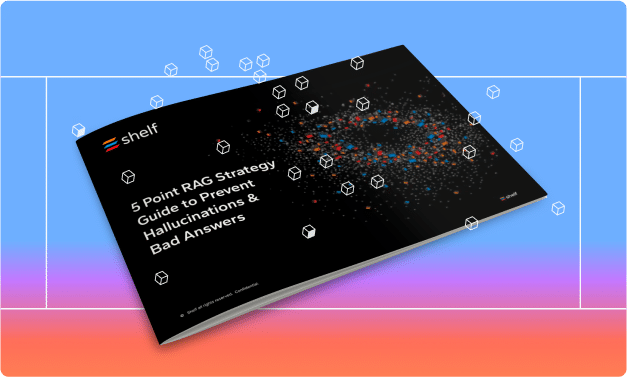Data wrangling is an essential process in data analytics that transforms unstructured data into a clean and usable format. As businesses increasingly rely on data-driven decision-making, the importance of efficient data wrangling cannot be overstated. It can make all the difference between a successful GenAI initiative and a failed one.
In this article, we’ll cover what it is, outline its benefits, explain how it works, and explore its future. Understanding these aspects will equip you with the knowledge to unlock the full potential of your data. Additionally, learn more about how Shelf’s Unstructured Data Management platform uses it to ensure more effective AI initiatives.
What is Data Wrangling?
Data wrangling – sometimes known as data munging – is the process of transforming raw unstructured data into a clean and organized format suitable for analysis. This involves converting complex, messy data into a structured, usable form.
Imagine you have a dataset with customer information collected from various sources, such as social media, emails, and online forms. The data is inconsistent, with missing fields, duplicate entries, and varied formats. Data wrangling involves cleaning up this dataset, standardizing the formats, removing duplicates, and filling in missing information so you can analyze customer behavior effectively.
Data Wrangling vs. ETL
Data wrangling and ETL (Extract, Transform, Load) both prepare data for analysis but differ in scope and methodology. Data wrangling is a manual process where data scientists and analysts clean and transform raw data into a usable format for immediate analysis. It typically deals with smaller, specific datasets and uses tools like Python, R, and Excel. Shelf is the exception to this rule, however, as our technology cleans and refines unstructured data, preparing it for use in GenAI initiatives.
ETL is a systematic, automated process used to integrate large volumes of data from multiple sources into a centralized data warehouse. It follows a structured pipeline to extract data from various sources, transform it to ensure consistency, and load it into a central repository for long-term use. ETL handles larger datasets and uses tools like Informatica, Talend, and Microsoft SSIS.
Why is Data Wrangling Important?
In its raw form, data often contains inconsistencies, errors, and gaps that can obscure insights and lead to incorrect conclusions. By systematically cleaning and transforming this data, wrangling aims to improve the accuracy, reliability, and meaningfulness of the information that’s used for decision-making.
Moreover, data wrangling is critical in today’s data-driven world where the volume and variety of data are continuously increasing. Organizations collect data from numerous sources such as social media, customer transactions, and IoT devices, which often come in different formats and structures.
Data wrangling integrates these disparate datasets, creating a unified and comprehensive view of the data landscape. This integration is vital for advanced analytics, machine learning models, and business intelligence applications. Without it, the potential of raw data remains untapped, limiting its value to your organization.
Benefits of Data Wrangling
Data wrangling is a critical step in the data preparation process because it enhances the efficiency and effectiveness of data analysis. Here are some key benefits of data wrangling:
Better Data Quality
It identifies and corrects errors, inconsistencies, and inaccuracies in raw data. This ensures that the data you work with is reliable, accurate, and trustworthy, which leads to more precise and dependable analysis results.
Enhanced Usability
Transforming raw data into a structured format makes it easier to analyze and interpret. This process allows you to convert complex datasets into a more accessible and understandable form, enabling more efficient and effective data analysis.
Time Savings
By automating the cleaning and transformation process, it saves significant time compared to manual data preparation. This lets data scientists focus on deriving insights and making data-driven decisions rather than spending time on tedious data cleaning tasks.
Better Decision-Making
With clean, structured, and high-quality data, decision-makers can rely on accurate information to guide their choices. Data wrangling ensures that the data used for analysis is robust, leading to more informed and confident business decisions.
Advanced Analytics
It prepares data for advanced analytics techniques, such as machine learning and predictive modeling. By ensuring that the data is in the right format and free from errors, it enhances the performance of analytical models.
Integrated Data from Multiple Sources
It lets you combine data from various sources into a cohesive dataset. This integration provides a comprehensive view of your data for a holistic and insightful analysis.
Increases Efficiency
Streamlining data preparation through data wrangling improves overall workflow efficiency. It reduces the time and effort required to clean and transform data. This creates faster and more productive data analysis cycles.
How Data Wrangling Works
It involves transforming raw data into a clean and usable format through a series of systematic steps. Each step ensures the data is prepared for accurate and effective analysis.
1. Explore
Exploration is the initial step where you examine the raw data to understand its structure, content, and quality. During this phase, you identify patterns, missing values, and potential anomalies. This understanding helps in planning the subsequent transformation and cleaning processes.
Example: You receive a customer feedback dataset. During exploration, you notice that the feedback dates are in different formats, some entries are incomplete, and there are duplicates.
2. Transform
In the transformation step, you convert the data from its raw format into a structured format suitable for analysis. This includes normalizing values, changing data types, and restructuring the data. Transformation ensures consistency and compatibility of data for further processing.
Example: The feedback dates are transformed into a standard format (e.g., YYYY-MM-DD). Numerical ratings are standardized to a common scale (e.g., all ratings converted to a 1-5 scale).
3. Cleanse
Cleansing involves correcting or removing errors, inconsistencies, and inaccuracies in the data. This step addresses issues like missing values, duplicate content, and incorrect entries. Cleansing is crucial for maintaining data integrity and reliability.
Example: You fill in missing feedback entries by inferring values from similar entries, remove duplicate feedback records, and correct any obvious errors (e.g., fixing typos in customer names).
4. Enrich
Data enrichment adds value to the dataset by incorporating additional information from external sources. This step enhances the data’s depth and breadth, providing more context and making it more informative. Enrichment often involves merging datasets and adding new fields.
Example: You enrich the customer feedback data by adding demographic information from a customer database. This provides context such as age, location, and purchase history.
5. Validate
Validation ensures the data meets predefined quality and accuracy standards. During this step, you apply automated rules and checks to verify data consistency, completeness, and correctness. Validation confirms that the data is ready for analysis.
Example: You validate the transformed and enriched data by checking for consistent formats, ensuring there are no duplicate records, and verifying that all required fields are filled.
6. Store
The final step is storing the cleaned, transformed, and validated data in a suitable location and format. This could be a database, data warehouse, or any storage system that supports easy access and analysis. Proper storage ensures that the data remains organized and accessible for future use.
Example: The prepared customer feedback data is stored in a central database or data warehouse, ready for further analysis and reporting.

Examples & Use Cases of Data Wrangling
Data wrangling is a versatile process used across various industries and applications. These examples illustrate the critical role of data wrangling across different fields.
Customer Data Integration
In marketing, data wrangling helps integrate customer data from multiple sources like CRM systems, social media, and email campaigns. By consolidating this data into a unified view, marketers can better understand customer behavior, segment audiences, and personalize marketing efforts.
Financial Reporting
Financial analysts use data wrangling to prepare financial statements and reports. This involves consolidating data from various accounting systems, cleaning and standardizing financial entries, and ensuring accuracy for compliance and decision-making purposes.
Healthcare Data Analysis
Healthcare providers use data wrangling to merge patient records, clinical trial data, and health monitoring information. This helps in creating comprehensive patient profiles, identifying treatment patterns, and improving patient outcomes through data-driven insights.
E-commerce Analytics
E-commerce companies wrangle data from website logs, transaction records, and customer feedback to analyze shopping patterns and optimize inventory. This process helps in identifying popular products, predicting demand, and enhancing the customer shopping experience.
Environmental Monitoring
Scientists use data wrangling to process data from sensors, satellites, and weather stations for environmental monitoring. This helps in tracking climate change, predicting weather patterns, and managing natural resources more effectively.
Social Media Analytics
Social media analysts wrangle data from various platforms to measure engagement, sentiment, and trends. By cleaning and standardizing this data, analysts can provide actionable insights into social media strategies and audience preferences.

The Future of Data Wrangling
As data continues to grow in volume, variety, and velocity, the future of data wrangling will evolve to meet new challenges and opportunities. Here are some key trends and developments shaping the future of data wrangling:
Automation and AI Integration
Automation will play a significant role in the future of data wrangling. AI and machine learning algorithms can automate repetitive and time-consuming tasks such as data cleaning, transformation, and validation. These technologies will enable faster and more accurate data preparation, allowing data professionals to focus on more strategic activities.
Enhanced User Interfaces
The development of more intuitive and user-friendly interfaces will make data wrangling accessible to a broader audience. Advanced visual tools and drag-and-drop interfaces will simplify the process so non-technical users can perform data wrangling tasks efficiently.
Real-Time Data Wrangling
With the increasing importance of real-time data analytics, future data wrangling tools will need to handle streaming data effectively. Real-time data wrangling will ensure that data is immediately cleaned, transformed, and ready for analysis.
Integration with Cloud Platforms
As more organizations migrate their data infrastructure to the cloud, data wrangling tools will increasingly integrate with cloud platforms. This will provide scalability, flexibility, and collaboration capabilities so teams can work on data wrangling tasks from anywhere.
Enhanced Data Governance and Security
Future data wrangling tools will place a greater emphasis on data governance and security. They will include features for tracking data lineage, managing access controls, and ensuring compliance with data privacy regulations. This will help organizations maintain data integrity and protect sensitive information.
Greater Focus on Unstructured Data
With the rise of big data, there is a growing need to wrangle unstructured data such as text, images, and videos. Future data wrangling tools will improve their capabilities to handle unstructured data for more comprehensive analysis and insights.
Predictive and Prescriptive Analytics
As data wrangling tools become more advanced, they will increasingly support predictive and prescriptive analytics. These tools will not only prepare data for analysis but also provide insights and recommendations based on the processed data.
Harness Your Data with Data Wrangling
It is an indispensable part of the data preparation process, ensuring that raw data is transformed into a format suitable for analysis. From enhancing data quality and usability to enabling advanced analytics, the benefits are extensive.
As we look to the future, advancements in automation, AI, and real-time processing will further revolutionize data wrangling, making it more efficient and accessible. By staying informed about these trends and techniques, you can ensure that your organization is well-prepared to harness the full potential of its data.




